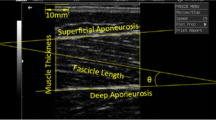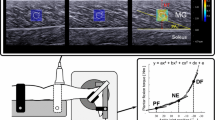Abstract
The aim of this study was to determine whether muscle stiffness measured in vivo was different between males and females. Distal displacement of the gastrocnemius medialis myotendinous junction was measured directly using ultrasonography during passive dorsiflexion in eight males and eight females (age range 19–28 years). Plantarflexion torque and myotendinous junction displacement were measured at 5° intervals, where 0° was with the foot at right angles to the tibia. Stiffness of the gastrocnemius medialis muscle was calculated between 0° and 25° of dorsiflexion, and defined as passive plantarflexion torque/distal displacement of the myotendinous junction (N m cm−1). Relative muscle stiffness was also calculated as distal displacement relative to resting muscle length, and as passive torque relative to plantarflexion maximal voluntary contraction torque. No significant gender difference was observed in passive dorsiflexion torque, or in passive torque/maximal voluntary torque throughout the range of motion. Distal displacement of the gastrocnemius myotendinous junction was 26% more in females than in males (P < 0.05). Myotendinous junction displacement was 5.0 ± 1.4% of resting gastrocnemius medialis length in females, and 3.9 ± 0.6% in males. Over 25° of passive dorsiflexion, gastrocnemius medialis muscle stiffness was greater in males than in females by 44% (P < 0.05). In conclusion, based on the in vivo assessment of myotendinous junction displacement, passive gastrocnemius medialis muscle stiffness is greater in males than in females.





Similar content being viewed by others
References
Blackburn JT, Riemann BL, Padua DA, Guskiewicz KM (2004) Sex comparison of extensibility, passive, and active stiffness of the knee flexors. Clin Biomech 19:36–43
Bryant AL, Clark RA, Bartold S, Murphy A, Bennell KL, Hohmann E, Marshall-Gradisnik S, Payne C, Crossley KM (2008) Effects of estrogen on the mechanical behavior of the human Achilles tendon in vivo. J Appl Physiol 105:1035–1043
Fukunaga T, Roy RR, Shellock FG, Hodgson JA, Edgerton VR (1996) Specific tension of human plantar flexors and dorsiflexors. J Appl Physiol 80:158–165
Gajdosik RL, Giuliani CA, Bohannon RW (1990) Passive compliance and length of the hamstring muscles of healthy men and women. Clin Biomech 5:23–29
Granata KP, Wilson SE, Padua DA (2002) Gender differences in active musculoskeletal stiffness. Part I. Quantification in controlled measurements of knee joint dynamics. J Electromyogr Kinesiol 12:119–126
Kjaer M, Hansen M (2008) The mystery of female connective tissue. J Appl Physiol 105:1026–1027
Kubo K, Kanehisa H, Kawakami Y, Fukunaga T (2001) Influence of static stretching on viscoelastic properties of human tendon structures in vivo. J Appl Physiol 90:520–527
Kubo K, Kanehisa H, Fukunaga T (2003) Gender differences in the viscoelastic properties of tendon structures. Euro J Appl Physiol 88:520–526
Maganaris CN, Paul JP (1999) In vivo human tendon mechanical properties. J Physiol 521(Pt 1):307–313
Maganaris CN, Paul JP (2002) Tensile properties of the in vivo human gastrocnemius tendon. J Biomech 35:1639–1646
Magnusson SP, Simonsen EB, Aagaard P, Boesen J, Johannsen F, Kjaer M (1997) Determinants of musculoskeletal flexibility: viscoelastic properties, cross-sectional area, EMG and stretch tolerance. Scand J Med Sci Sport 7:195–202
Mahieu N, Witvrouw E, Stevens V, Willems T, Vandertraeten G, Cambier D (2004) Test-retest reliability of measuring the passive stiffness of the Achilles tendon using ultrasonography. Isok Exerc Sci 12:185–191
McHugh MP, Kremenic IJ, Fox MB, Gleim GW (1998) The role of mechanical and neural restraints to joint range of motion during passive stretch. Med Sci Sport Exerc 30:928–932
Moran AL, Nelson SA, Landisch RM, Warren GL, Lowe DA (2007) Estradiol replacement reverses ovariectomy-induced muscle contractile and myosin dysfunction in mature female mice. J Appl Physiol 102:1387–1393
Morse CI, Thom JM, Reeves ND, Birch KM, Narici MV (2005) In vivo physiological cross-sectional area and specific force are reduced in the gastrocnemius of elderly men. J Appl Physiol 99:1050–1055
Morse CI, Degens H, Seynnes OR, Maganaris CN, Jones DA (2008) The acute effect of stretching on the passive stiffness of the human gastrocnemius muscle tendon unit. J Physiol 586:97–106
Onambele GN, Burgess K, Pearson SJ (2007) Gender-specific in vivo measurement of the structural and mechanical properties of the human patellar tendon. J Orthop Res 25:1635–1642
Padua DA, Carcia CR, Arnold BL, Granata KP (2005) Gender differences in leg stiffness and stiffness recruitment strategy during two-legged hopping. J Motor Behav 37:111–125
Purslow PP (1989) Strain-induced reorientation of an intramuscular connective tissue network: implications for passive muscle elasticity. J Biomech 22:21–31
Taylor DC, Dalton JD Jr, Seaber AV, Garrett WE Jr (1990) Viscoelastic properties of muscle-tendon units. The biomechanical effects of stretching. Am J Sport Med 18:300–309
Visser JJ, Hoogkamer JE, Bobbert MF, Huijing PA (1990) Length and moment arm of human leg muscles as a function of knee and hip-joint angles. Euro J Appl Physiol 61:453–460
Author information
Authors and Affiliations
Corresponding author
Additional information
Communicated by Toshio Moritani.
Rights and permissions
About this article
Cite this article
Morse, C.I. Gender differences in the passive stiffness of the human gastrocnemius muscle during stretch. Eur J Appl Physiol 111, 2149–2154 (2011). https://doi.org/10.1007/s00421-011-1845-z
Received:
Accepted:
Published:
Issue Date:
DOI: https://doi.org/10.1007/s00421-011-1845-z




